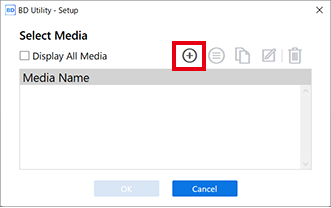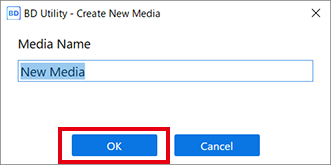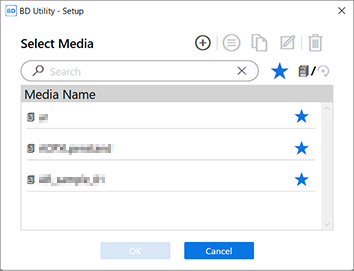Step 3: Setting Up the Object
You can keep the front cover open when you set the height of the flat table, the print origin, or other settings for a closer view as you work.
However, clicking OK with these settings configured may cause the print-head carriage or flat table to start moving. Therefore, when the front cover is open, be careful not to touch any moving parts as you work.
-
On the Utility home screen, click
 Setup.
Setup.
-
Register/select the object.
MEMO In Utility, "media" is used on the window used to register/manage objects.
- When printing on an object for the first time
- Click
 .
.
- Enter the name of the new object, and then click OK.
Previously registered media names cannot be used. Enter a new media name.

MEMO-
We recommend that you set frequently used objects as favorites.
- Click
 next to the name of a registered object to change this icon to
next to the name of a registered object to change this icon to  .
. - Click
 next to the search box.The icon changes to
next to the search box.The icon changes to , and the list of media set as favorites appears.
, and the list of media set as favorites appears.
- Click
-
You can display all registered objects.
If a rotary axis unit is not attached, the normal objects are displayed. If a rotary axis unit is attached, the objects to be used with this unit are displayed.
Click
 or
or  to display all registered objects.
to display all registered objects.
- Click
- For pre-registered objectsSelect the object, and then click OK.MEMO You can use the favorites function and the search function to easily find registered objects.Steps 3 through 5 are not required. Proceed to step 6.IMPORTANT If the height may have changed due to a change in the securing method, suction mat, or similar, set the height (step 4).
- When printing on an object for the first time
-
In the Object Type window, select one of the following, and then click OK.
- Transparent object: Select Smartphone Cases or Others from the Transparent pull-down menu.
- Opaque object: Select Opaque.
MEMO- Transparent: A hand placed on the other side of the object can be seen through it.
- Opaque: A hand placed on the other side of the object cannot be seen through it.
See Object (Media) Registration Items for more information on objects.
-
Click Change next to Flat Table Height to set the height of the object.
-
Select Print Origin from Origin Relative or Center Relative.
For information about Print Origin, refer to Object (Media) Registration Items.
-
Click Change next to Print Origin and Printing Area, and then set the printable area.
This section explains how to configure settings when the Origin Relative is selected. If the distance from the lower right (S: 0 mm [0 in.], F: 0 mm [0 in.]*1) of the maximum printing area is clear, use Numeric Input to enter a numerical value.
MEMO When the Printing Area setting is finished, the print-head carriage returns to its original position after it has been left in the same position for approximately 3 minutes to prevent the print heads from drying out. Perform the procedure again.IMPORTANT About Printing AreaSince the Origin Relative is specified here, the upper left of the Printing Area is automatically set to the maximum position (S: 210 mm [8.26 in.], F: 148 mm [5.82 in.]).
-
Click OK.
Setup in progress. is displayed. When setup is completed, you are returned to the home screen, and the registered object name, and the set Flat Table Height, Print Origin, and Printing Area are displayed.
 or
or  on the right side of the window to align the highest point of the object with the forward-back position of the head gap sensor.
on the right side of the window to align the highest point of the object with the forward-back position of the head gap sensor. , or
, or  , and then move the pointer to specify the print origin (lower right of the printing area).
, and then move the pointer to specify the print origin (lower right of the printing area).